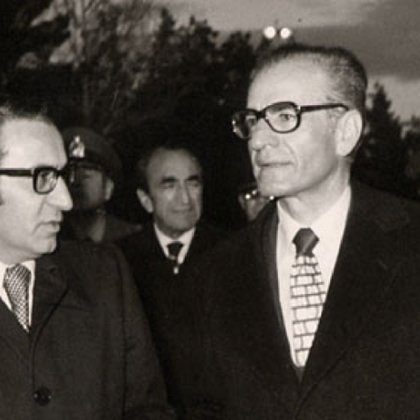IRAN'S NUCLEAR PROGRAM BEGAN IN THE SHAH REZA PAHLAVI'S ERA,IRAN RATIFIED THE NUCLEAR NON PROLIFERATION TREATY IN 1970, AND SINCE FEBRUARY 1992 HAS ALLOWED THE IAEA ANY OF IT'S NUCLEAR FACILITIES.PRIOR TO 2003 NO IAEA INSPECTIONS HAS REVEALED IRAN'S VIOLATION OF THE NPT.
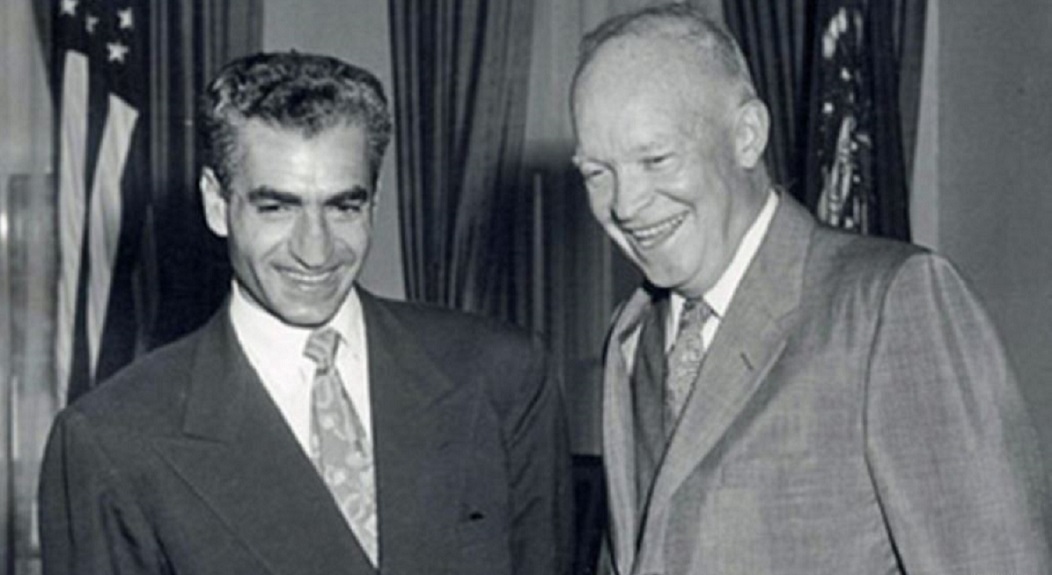 U.S. President Dwight D. Eisenhower (right) meets with Iran's Mohammad Reza Shah Pahlavi in 1954.The start of Iran's nuclear program can arguably be pegged to December 8, 1953.It was on that date that U.S. President Dwight D. Eisenhower delivered what was later dubbed his Atoms For Peace speech to the United Nations General Assembly.Eisenhower used the occasion to sell a wary world on the positives of nuclear power and to spell out a visionary plan to use it "to provide abundant electrical energy in the power-starved areas of the world.
U.S. President Dwight D. Eisenhower (right) meets with Iran's Mohammad Reza Shah Pahlavi in 1954.The start of Iran's nuclear program can arguably be pegged to December 8, 1953.It was on that date that U.S. President Dwight D. Eisenhower delivered what was later dubbed his Atoms For Peace speech to the United Nations General Assembly.Eisenhower used the occasion to sell a wary world on the positives of nuclear power and to spell out a visionary plan to use it "to provide abundant electrical energy in the power-starved areas of the world.Under the Shah, Iran launched a series of ambitious nuclear projects that relied on assistance from the United States and Europe. According to Akbar Etemad, the President of the Atomic Energy Organization of Iran (AEOI), from 1974 through 1978, Iran was already carrying out nuclear research and education at the University of Tehran when the NPT entered into force on March 5, 1970. The work centered on a five megawatt research reactor supplied by the United States, which began operation in 1967.Iran's nuclear program began in the Shah's era, including a plan to build 20 nuclear power reactors. Two power reactors in Bushehr, on the coast of the Persian Gulf, were started but remained unfinished when they were bombed and damaged by the Iraqis during the Iran-Iraq war. Following the revolution in 1979, all nuclear activity was suspended, though subsequently work was resumed on a somewhat more modest scale. Current plans extend to the construction of 15 power reactors and two research reactors.Research and development efforts also were conducted by the Shah's regime on fissile material production, although these efforts were halted during the Iranian revolution and the Iran-Iraq war.The current nuclear program is headed by the President, the commander of the Iranian Revulutionary Gaurd Corps (IRGC), the head of the Defense Industries Organization, and the head of Iran's Atomic Energy Organization (IAEO). These leaders continue the pursuit of WMD's and support Chemical, Biological, and Nuclear programs against all pressures from the United States and its allies.Iran ratified the Nuclear Nonproliferation Treaty in 1970, and since February 1992 has allowed the IAEA to inspect any of its nuclear facilities. Prior to 2003 no IAEA inspections had revealed Tehran's violations of the NPT.Since the end of the Iran-Iraq War, Tehran redoubled its efforts to develop weapons of mass destruction (WMD) and ballistic missiles. In addition to Iran's legitimate efforts to develop its nuclear power-generation industry, it is believed to be operating a parallel clandestine nuclear weapons program. Iran appears to be following a policy of complying with the NPT and building its nuclear power program in such a way that if the appropriate political decision is made, know-how gained in the peaceful sphere (specialists and equipment) could be used to create nuclear weapons.It is evident that Iran's efforts are focused both on uranium enrichment and a parallel plutonium effort. Iran claims it is trying to establish a complete nuclear fuel cycle to support a civilian energy program, but this same fuel cycle would be applicable to a nuclear weapons development program. Iran appears to have spread their nuclear activities around a number of sites to reduce the risk of detection or attack.During the 1970s the Shah of Iran argued, like current Iranian leaders today, for a nuclear energy capability on the basis of national "rights," while the Ford and Carter administrations worried about nuclear weapons possibilities, according to newly declassified documents published today by the National Security Archive for the first time. Uranium enrichment capability is now the major point of controversy between Tehran and the world community, while during the 1970s Washington's greatest concern was that Iran sought a capability to produce plutonium, but in both instances the implication was that a nuclear weapons option might not be far away.The 1979 Iranian Revolution derailed the agreement, but the approach that the Ford and Carter administrations took shows significant continuity with contemporary U.S. and world policy, which holds that Iran must not use its technological capabilities to produce nuclear weapons.The 1970s nuclear negotiations have other parallels with the current situation.But the Shah and his government made the exact same statements in the 1970s. The record also shows that the Shah's regime and the current Iranian government have made the same claims that their pursuit of nuclear technology was an inherent national entitlement. No country "has a right to dictate nuclear policy to another," said the Shah's chief atomic energy official in 1977.Iran does not currently have nuclear weapons, and would appear to be about two years away from acquiring nuclear weapons. By some time in 2006, however, Iran could be producting fissile material for atomic bombs using both uranium enriched at Natanz and plutonium produced at Arak. The Natanz facility might produce enough uranium for about five bombs every year, and the Arak facility might produced enough plutonium for as many as three bombs every year.If Iran did acquire atomic bombs, it would put pressure on other countries in the region do the same. Many Arab countries believe it is unfair that Israel has nuclear weapons. If Arab countries, notably Saudi Arabia but also Egypt and possibly Syria, found themselves caught between a nuclear-armed Israel and a nuclear-armed Iran, it would greatly increase pressures to pursue their own nuclear options. This could result in a regional arms race in the Middle East which is likely to be quite destabilizing, given the number and intensity of conflicts and instabilities in the region.Under the plan, Eisenhower said the United States would provide the necessary technology and expertise to nations eager to create civilian nuclear programs.To make sure nuclear materials were not diverted to making weapons, Eisenhower proposed establishing a watchdog within the UN. That watchdog would later become the International Atomic Energy Agency (IAEA).To execute Eisenhower's vision, Washington established the Atoms For Peace program.Under the program, the United States would provide research reactors, fuel, and scientific training to developing countries eager to harness the power of the atom.Mark Fitzpatrick, a director at London's International Institute for Strategic Studies, says the endeavor was in part motivated by the Cold War rivalry between Moscow and Washington, as they vied to win over allies with the allure of nuclear power.Among the first countries to take the United States up on its offer was Iran.In 1957, Tehran and Washington signed a nuclear cooperation agreement, formally titled the Cooperation Concerning Civil Uses of Atoms.Business as well as politics drove the United States to sign the deal, according to Fitzpatrick."Iran was eyeing a vast nuclear energy program, and presumably would have purchased much of the equipment for that program from American companies," Fitzpatrick said.Two years later, in 1959, Iran's Mohammad Reza Shah Pahlavi created the Tehran Nuclear Research Center (TNRC) at the University of Tehran.It was there in the Iranian capital in 1967 that the United States delivered a five-megawatt nuclear research reactor and the highly enriched uranium needed to fuel it.This nuclear reactor, in particular, and the TNRC, in general, would later reportedly be used by Tehran to carry out some of its more controversial work, including some of the country's earliest experiments with uranium enrichment.But to prove to the world its nuclear plans were peaceful, Iran signed the Nuclear Nonproliferation Treaty (NPT) in July 1968, on the first day it was opened for signature. Tehran ratified the treaty in 1970, putting it among the first group of states to do so and on paper giving it the right to enrich uranium.To oversee the country's nuclear program, the shah created the Atomic Energy Organization of Iran (AEOI).Needing nuclear experts, the AEOI in 1975 turned to the Massachusetts Institute of Technology one of the top engineering universities in the United States to create a special program to provide Iranian experts with scientific and technological training on nuclear energy.
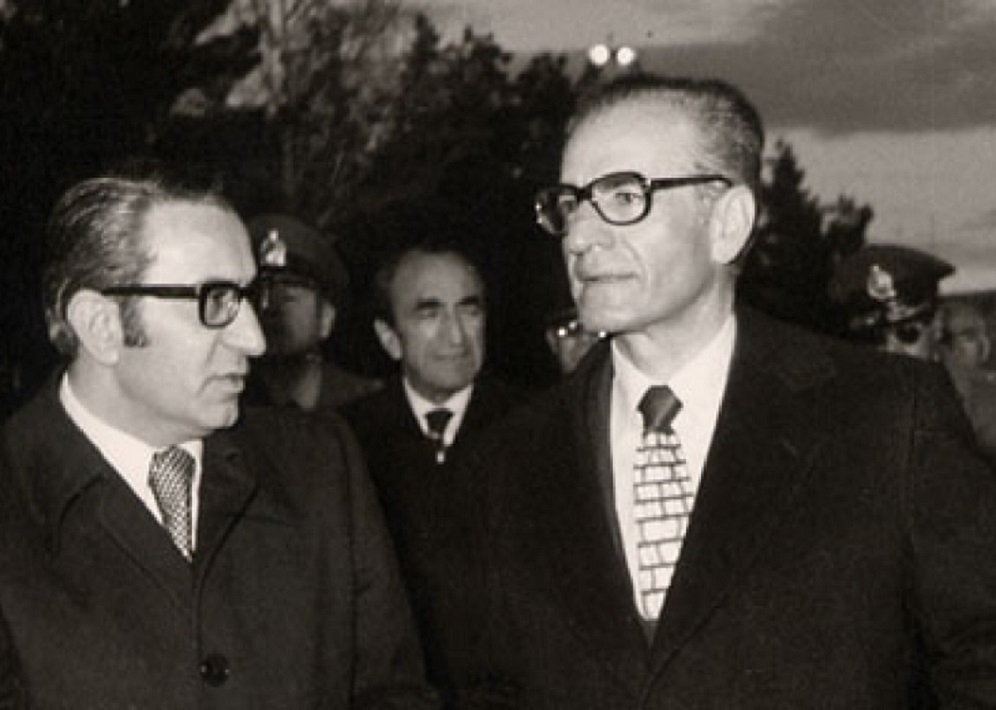 Iran’s nuclear program began in 1959 with a small reactor given by the United States to Tehran University as part of the "Atoms for Peace" program announced by President Dwight D. Eisenhower in December 1953. But that only whetted the Iranian monarch’s appetite: With his increased oil revenues, and with his new vision of Iran as the hegemonic force in the region, a nuclear program became for Shah Pahlavi the symbol of progress and power. He summoned Akbar Etemad, a trained nuclear physicist, to the royal court in 1973, told him of his desire to launch a nuclear program, and asked Etemad to develop a master plan.
Iran’s nuclear program began in 1959 with a small reactor given by the United States to Tehran University as part of the "Atoms for Peace" program announced by President Dwight D. Eisenhower in December 1953. But that only whetted the Iranian monarch’s appetite: With his increased oil revenues, and with his new vision of Iran as the hegemonic force in the region, a nuclear program became for Shah Pahlavi the symbol of progress and power. He summoned Akbar Etemad, a trained nuclear physicist, to the royal court in 1973, told him of his desire to launch a nuclear program, and asked Etemad to develop a master plan.
Dr Akbar Etemad is the father of Iran's nuclear programme. After graduating from Lausanne University in 1963, Etemad returned to Iran and became a nuclear adviser to the Iranian government. He was the president of the Atomic Energy Organisation of Iran (AEOI) between 1974 and 1978.The rising oil prices of the early 1970s allowed the Shah of Iran, Mohammad Reza Pahlavi, to embark on ambitious industrial and military projects. Under Etemad's supervision, Iran launched an extensive nuclear energy programme. The goal was to produce roughly 23,000 megawatts of electrical power from a series of nuclear power stations within 20 years.A host of contracts between Iran and nuclear suppliers in Europe and the United States followed: Iran struck a deal with Kraftwerk Union, a Siemens subsidiary of then West Germany, to build two 1,200-megawatt reactors at Bushehr, and negotiated with the French company Framatome for two additional 900-megawatt reactors. In 1974, Iran reportedly invested $1bn in a French uranium enrichment plant owned by Eurodif, a European consortium. The shah's plans and Iran's co-operation with Europe and the US came to an abrupt halt after the 1979 Islamic Revolution. Many of Etemad's colleagues fled the country or were summarily executed by the new rulers, and Etemad left Iran for France, where he has been living for the past 30 years. Yet losing his position has not made him bitter. He primarily blames the Europeans and the Americans for the current Iranian nuclear crisis. He believes that the west does not respect Iran's sovereignty - and that it is natural for Iranians not to trust Europeans and Americans. 1970s record the Shah of Iran’s insistence that his country had “rights” under the Nuclear Nonproliferation Treaty (NPT) to develop such a program. The Shah further claimed his interest was only in peaceful activities, and cited among other justifications the need to be able to compensate for the eventual decline in Iran’s oil reserves. The current Iranian government, whose predecessors overthrew the Shah in 1979, has propounded the same arguments. For their part, Obama administration officials have expressed concerns -- echoed far more sharply by opponents of a deal -- about the threat of proliferation inherent in any agreement that allows Iran to develop nuclear energy resources. Doubts have also sprung up from many quarters in recent years that Tehran’s aims are purely peaceful, and skepticism is even more rife about the Islamic Republic’s claim that it needs to address the fact that its oil resources are finite. As during the Ford and Carter years, worries about nuclear weapons being available for supporting terrorism have hampered the current talks. Recently declassified documents from the Carter and Ford presidential libraries; the departments of defense, energy, and state; and the National Security Council (NSC) show that every element of today’s impasse between the U.S. government and the Islamic Republic was also present in the negotiations with the shah. These range from Iran’s insistence on its Nuclear Non-Proliferation Treaty (NPT) right to a "full fuel cycle," its complaint that the United States was singling it out for guarantees no other country was required to give, and finally the U.S. offer to make Iran part of an international consortium to enrich uranium outside Iran, the so-called "Russian solution." The shah repeatedly insisted that at least he did not want a nuclear bomb yet he was adamant that Iran not be treated as a second-class citizen. These negotiations, details of which have not been published before now, don’t just expose the regime’s lies about the alleged U.S. double standard, they also offer a useful guide for Western negotiators in navigating the waters of Iranian nationalism, both real and feigned. While Germany and France showed immediate eagerness to sell Iran its desired reactors, the United States was initially reluctant to sell any, "without conditions limiting [the shah’s] freedom of action," according to the text of a U.S. governmental memo. The German company Kraftwerk signed the first agreement to build the now-famous Bushehr reactor with an initial completion date of 1981 and an estimated cost of $3 billion. As Bushehr was located in a dangerous zone that was prone to frequent and strong seismic activity, extra funds were set aside to protect the site against the dangers of an earthquake. It was said at the time that the German government was so eager to find a foothold in the Iranian market that it guaranteed Kraftwerk’s investment against any loss. U.S. companies, on the other hand, were barred from these contracts until Washington’s concerns about the shah’s intentions were addressed.The shah was adamant that Iran should enjoy its "full rights," as he put it at the time, within the NPT — an agreement Iran had immediately signed upon its formulation and that calls for non-nuclear states to forfeit the search for a nuclear bomb in return for easy access to the peaceful uses of nuclear energy. But Iran not only insisted on the right to have the full fuel cycle, it also was interested in processing plutonium a faster way to a nuclear bomb than enriched uranium.In remarks that echo Ahmadinejad’s provocative boasts today, in February 1974, following a Franco-Iranian agreement to cooperate on uranium enrichment, the shah told Le Monde that one day "sooner than is believed," Iran would be "in possession of a nuclear bomb." The shah’s surprising comment was at least partially in response to the 1974 Indian test of a nuclear weapon.
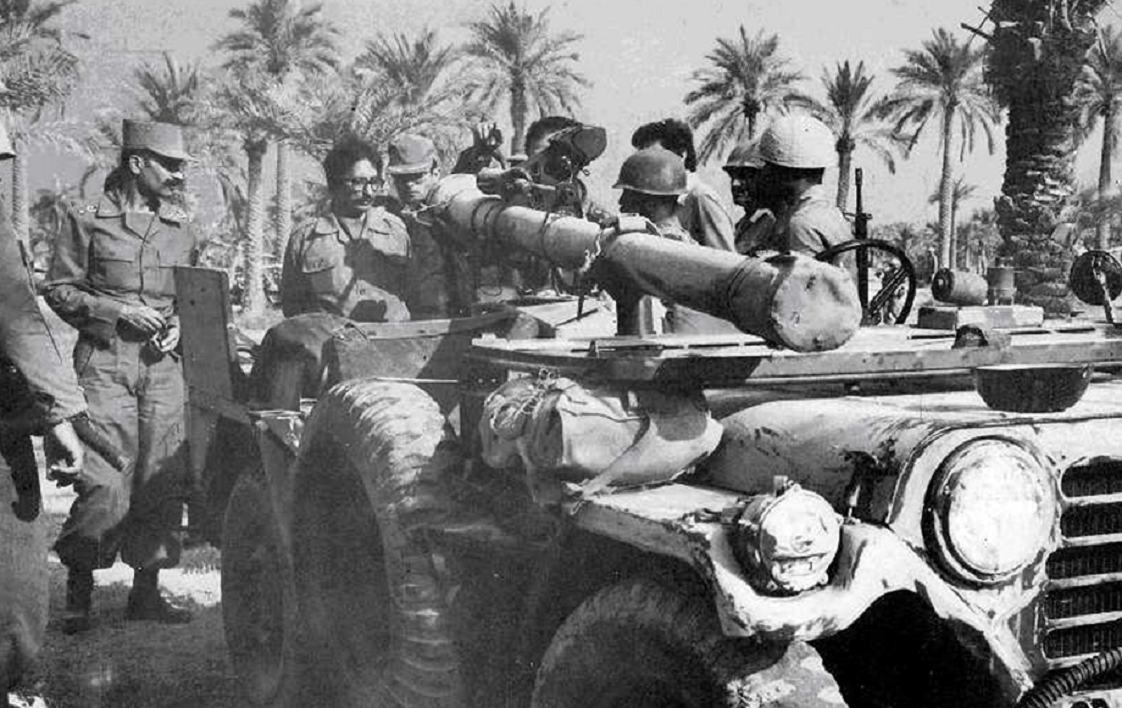
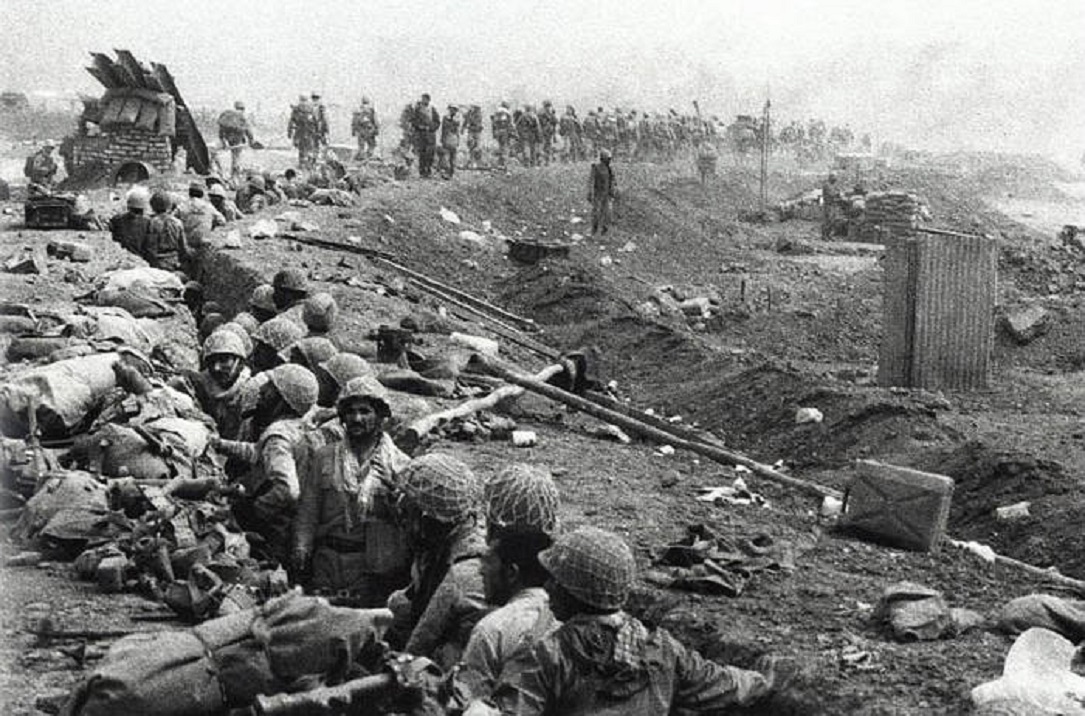 Iran - Irak war, 22 September 1980 – 20 August 1988,Iraqi leader, Saddam Hussein, launched a full scale war, initially by ordering his Air Force to destroy Iranian air fields. The invasion followed months of border conflict and diplomatic rows between the new Shia Islamic Republic in Tehran and the Ba’athist leader aspiring to become the leader of the Arab world.
Iran - Irak war, 22 September 1980 – 20 August 1988,Iraqi leader, Saddam Hussein, launched a full scale war, initially by ordering his Air Force to destroy Iranian air fields. The invasion followed months of border conflict and diplomatic rows between the new Shia Islamic Republic in Tehran and the Ba’athist leader aspiring to become the leader of the Arab world.
During the 1970s, under the last shah, Iran’s nuclear program seemed to be gearing up so that nation could gain the option of declaring weapons capability if deemed necessary and at a point when the international community could no longer forestall it. So re-examining activities during the Pahlavi dynasty and using them as a context for the Islamic Republic’s more recent actions casts light upon motivations for pursuing weaponization and intransigence in reaching accommodation with the West after the rise of the ayatollahs, despite differences between the two Iranian regimes.During the 1970s just as after the Islamic Revolution, Iran’s quest to become a nuclear power was rooted at least partially in the regional dynamics of its location between South Asia and the Middle East. The shah envisioned his nuclear program as a response to atomic efforts by India, Pakistan, and Israel. He even hinted in June 1974 that the national security of Iran may be best served by possessing a nuclear deterrent: “If in this region each little country tries to arm itself with armaments that are precarious, even elementary, but nuclear, then perhaps the national interests of any country at all would demand it do the same .” The shah did add, to placate his international allies, “But I would find that completely ridiculous .” After all, Iran had committed itself to the NPT when that multinational agreement was introduced in July 1968.Nonetheless, other nations were suspicious based on imperial Iran’s growing appetite for sophisticated weapons and the shah’s harkening back to the nation’s historical hegemony. So the possibility of Iran harboring nuclear weapons ambitions came sharply into international focus when the shah asserted that possibility to a French journalist in June 1974. Asked if Iran would one day possess a nuclear weapon like India had just one month previously, the shah declared: “Without any doubt, and sooner than one would think .”Nuclear weapons require sophisticated targeting and delivery systems. At the present, with years of sanctions in place, the regular Iranian Navy and its Islamic Revolutionary Guard Corps (IRGC) counterpart have been forced to innovate, rather successfully, in domestically enhancing maritime nuclear warfare capabilities . In January 1975, however, the shah sought to purchase such nuclear-capable technology. Seeking to push through a deal for nuclear submarines from France, Iranian negotiators even claimed the administration in Washington had “been hinting that the U. S. might sell them.” US Secretary of State Henry Kissinger learned of this from French Presidential Secretary General Pierre Brousalette.Undeterred by mounting international concern over his nuclear program, Shah Mohammad Reza Pahlavi even proposed acquiring six to eight reactors from American suppliers plus more from French and German companies. His stated aim was to meet domestic energy requirements through atomic fission thereby reserving Iran’s petrochemical wealth for export to energy-hungry foreigners . At first glance, the proposal seemed like a win-win situation for everyone. Moreover, as the US government’s production of enriched nuclear fuel began reaching full capacity and plans were made to assemble a private sector consortium to add further capacity, the shah offered to purchase a 30 percent stake. The gesture was significant, as other interested parties had proven reluctant to commit significant funds. Iran eventually loaned US $1.18 billion to the French Atomic Energy Commission and was slated to acquire a 10 percent stake in the French Eurodif uranium enrichment plant. Although that stake did not materialize, the Islamic Republic remains an indirect investor in that uranium facility through a Franco-Iranian consortium.At that time during the Ford Administration (1974–1977), however, alarm in Washington over nuclear proliferation resulted in a provision that Tehran would have to relinquish reprocessing of atomic fuel to a multilateral conglomerate or allow direct American oversight within Iran. The shah denounced those conditions as discriminatory because Iran was a member of the NPT and therefore entitled to nuclear technology for civilian purposes. The situation bears an uncanny resemblance specifically to events in 2009 when the fuel swap proposal from the five permanent members of the UN Security Council and Germany failed to win Supreme Leader Ayatollah Ali Khamenei’s approval and broadly to the vexed history of failed attempts at nuclear safeguards for Iran.Yet, whether the shah would have honored the agreement will never be known for he was overthrown the following year. US cooperation with Iran on nuclear and other issues was halted with the revolution in 1979 that established the Islamic Republic. It is likely, however, that Iran would have ended up confronting the West generally and the US specifically over its nuclear program even if the shah had remained on the throne and continued to be an American ally. Indeed, the shah’s thinly-masked quest for nuclear power was apparent to officials who served him, even as Western governments remained uncertain of the end game just as they seem to be with the ayatollahs. Minister of Court Asadollah Alam wrote in his diary on 29 November 1975 that the shah’s scheme “though he denies it, probably includes our manufacturing of a nuclear deterrent.” Akbar Etemad, the shah’s chief atomic energy adviser , was more definitive about the quest atomic weapons when interviewed after the Pahlavi dynasty had been part of the shah's plan was to build nuclear bombs.
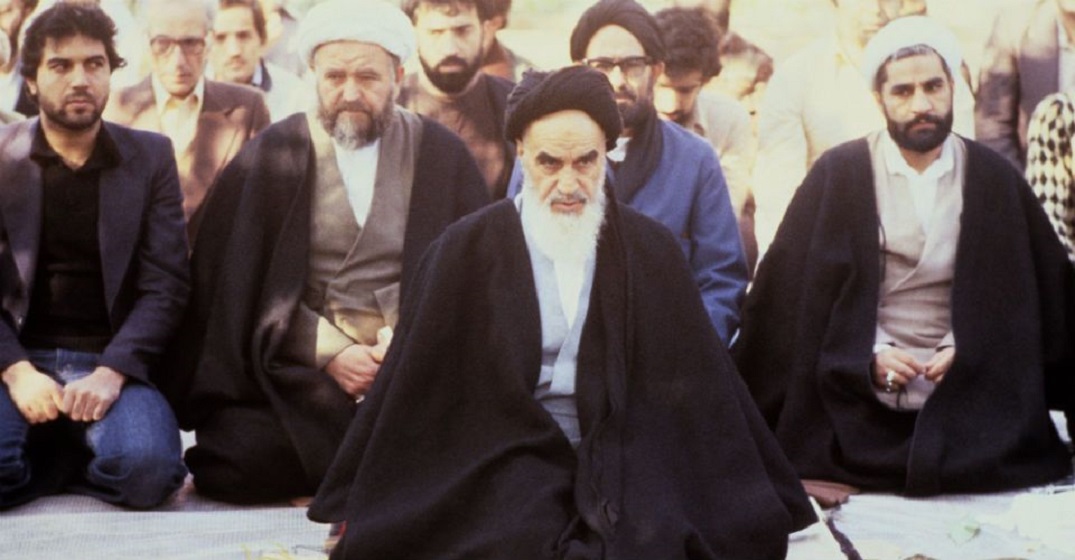 In an exclusive interview, a top Iranian official says that Khomeini personally stopped him from building Iran's WMD program A few Iranian sources have previously pointed to a fatwa by the Islamic Republic’s first supreme leader, Ayatollah Ruhollah Khomeini, prohibiting chemical weapons as the explanation for why Iran did not deploy these weapons during the war with Iraq. But no details have ever been made public on when and how Khomeini issued such a fatwa, so it has been ignored for decades.
In an exclusive interview, a top Iranian official says that Khomeini personally stopped him from building Iran's WMD program A few Iranian sources have previously pointed to a fatwa by the Islamic Republic’s first supreme leader, Ayatollah Ruhollah Khomeini, prohibiting chemical weapons as the explanation for why Iran did not deploy these weapons during the war with Iraq. But no details have ever been made public on when and how Khomeini issued such a fatwa, so it has been ignored for decades.
Ayatollah Khomeni famously said the unfinished nuclear power plants in Bushehr should be used as silos to store wheat.This attitude lasted into the 1980s. But by then, Iran was fighting a brutal war against neighboring Iraq, led by Saddam Hussein. As part of that war, Saddam repeatedly bombed the Bushehr nuclear facility, which was not operational at the time.The war, which lasted from 1980 to 1988, also created severe power shortages in Iran.Eventually, Iran's leaders decided to revive the nuclear program, though the precise reason was not clear.Having experienced colossal military and civilian causalities during the Iraq-instigated border war from 1980 and 1988, Iran’s leadership concluded that survival of their nation and regime were paramount. Like the shah before them, the ayatollahs turned to a nuclear program in the hope of assuaging those concerns. After the Islamic Republic reluctantly agreed to termination of hostilities with Iraq, Ayatollah Akbar Hashemi Rafsanjani laid the groundwork for the nuclear program’s recommencement. Even religious ideals which regarded nuclear and other weapons of mass destruction as haram or prohibited were cast aside. Speaking to the IRGC in October 1988, while serving as Speaker of Parliament, Rafsanjani advocated developing weapons of mass destruction “because the need for such armaments was made very clear during the [Iran-Iraq] war … [so] we should fully equip ourselves both in the offensive and defense use of chemical, bacteriological, and radiological weapons .” For a similar statement see this .Once a political consensus had been achieved in late 1988, Mohsen Rezai who commanded the IRGC, and subsequently served as Secretary of the Expediency Guidance Council, wrote to then Supreme Leader Ayatollah Ruhollah Khomeini requesting both religious acquiescence and administrative permission for the revolutionary guards to initiate a nuclear weapons program. Mir Hossein Mousavi who served as Prime Minister from 1981 to 1989 supported the request by Rezai and the campaign by Rafsanjani . Although Supreme Leader Khomeini had initially been opposed to the atom’s might, they were able to sway Iran’s revolutionary founder into agreeing that “We have nothing against setting up atomic installations ” . So the Islamic Republic commenced fledgling steps toward nuclear power.Subsequently as two-term president of Iran from 1989 to 1997, Rafsanjani ensured Iran fully resumed its quest toward nuclearization. His presidential successors Seyyed Mohammad Khatami who held office from 1997 to 2005 and Mahmoud Ahmadinejad who has been in office since 2005 continued the energy and weapon programs set up by Rafsanjani, Rezai, and Mousavi. Khatami did suspend uranium enrichment in 2003 hoping to improve relations with the US, but legislative elections in 2004 saw resurgence of hardliners on the Iranian political scene and a recommitment to atomic goals. (See this , this , and this ). Over the next two decades the Islamic Republic turned not only to its pre-revolutionary technology but also to foreign sources including A. Q. Khan’s illicit Pakistan-based network, North Korea, and the People’s Republic of China as it steadily built-up domestic nuclear capacity.The report says an attack could delay Tehran's development of an atomic bomb for a few years. If the United States alone, or with Israel, carried out “extended military strikes," Iran’s ability to build a nuclear bomb could be delayed by two to four years, it says. The report estimated that a military strike by Israel alone could delay Iran’s nuclear program by up to two years. "You can't kill intellectual power," said retired U.S. Army Lieutenant General Frank Kearney, who endorsed the report. He is a former deputy director at the National Counterterrorism Center and former deputy commander of U.S. Special Operations Command.In a letter to the International Atomic Energy Agency dated 23 January 2013, Tehran said it would introduce new centrifuges to its main enrichment plant near the central town of Natanz. The letter from the Atomic Energy Organization of Iran (AEOI) informed the Agency that 'centrifuge machines type IR2m will be used in Unit A-22' at the Fuel Enrichment Plant (FEP) at Natanz. It was not clear how many of the upgraded centrifuges Iran aimed to put in place at Natanz, which is designed for tens of thousands of machines, but the wording of the IAEA's note implied it could be up to roughly 3,000. A unit can house more than 3,000 centrifuges. About 10,400 IR-1 centrifuges were installed at Natanz as of late 2012, an IAEA report said in November 2012. Using the IR-2m in large numbers would enable Iran to enrich uranium much faster.Previously,Iran's supreme leader rejected a proposal for direct talks about its nuclear program with the United States, saying negotiations will not solve anything. Ayatollah Ali Khamenei said in a statement posted on his website 07 February 2013 that the US wanted to talk while threatening to punish Iran, and that his country will not be intimidated. On 06 February 2013 President Mahmoud Ahmadinejad, in reaction to .Iran stopped dismantling centrifuges in two uranium enrichment plants, state media reported on 10 November 2015. The announcement came days after conservative lawmakers complained to President Hassan Rouhani that the process was too rushed, Reuters said. Iran began shutting down inactive centrifuges at the Natanz and Fordow plants under the terms of a deal struck with world powers in July. The dismantling process “stopped with a warning," Ali Shamkhani, Secretary of the National Security Council, was quoted as saying by the ISNA news agency. The dismantling process stopped in Fordow because of the lawmakers’ letter.By ovember 2015 Iran was keeping on standby thousands of centrifuge machines that could easily be returned to service for use in a prohibited weapons program. Iran's main nuclear-enrichment center had 11,308 centrifuges installed, as of mid-November 2015 — some 3,000 fewer than were in service before October 18, when the nuclear agreement went into effect. The IAEA said some centrifuges also have been removed from a smaller Iranian facility.Iran's stockpile of low-enriched uranium had increased in the past three months, instead of being significantly reduced, as was required.Iran said 30 November 2015 that would be no final implementation of a nuclear deal with world powers unless the probe into allegations of past weapons research was closed. The declaration, by top security official Admiral Ali Shamkhani, came after the head of the UN nuclear watchdog said a report into the possible military dimensions of Iran’s activities would not be “black and white." Shamkhani is secretary of Iran’s Supreme National Security Council (SNSC), the country’s highest security body, which was tasked with supervising the nuclear deal.On December 15, 2015 the IAEA officially closed its more than decade-old investigation into allegations that Iran once worked to develop nuclear weapons. The 35-nation board of the International Atomic Energy Agency unanimously approved a resolution Tuesday to close the investigation. The approval came after IAEA chief Yukiya Amano presented his final report on the matter to the IAEA board, saying it gave clear answers on whether Iran worked toward nuclear arms.The conclusion was that Iran carried out "a range of activities relevant to the development of a nuclear explosive device," mostly before 2003. The IAEA recently released a report indicating there are no credible signs that Iran's efforts to build a nuclear weapon lasted past 2009.Iran shipped its stockpile of low-enriched uranium to Russia as a key step in fulfilling its commitments under a landmark nuclear agreement clinched between Tehran and the P5+1 group of countries. The export on 28 December 2015 of uranium took place within the framework of the Joint Comprehensive Plan of Action (JCPOA). US Secretary of State John Kerry said, "The shipment included the removal of all of Iran's nuclear material enriched to 20 percent that was not already in the form of fabricated fuel plates for the Tehran Research Reactor.This removal of all this enriched material out of Iran is a significant step toward Iran meeting its commitment to have no more than 300 kilograms of low-enriched uranium." Iran sent over 25,000 pounds (over 11 metric tons) of low-enriched uranium materials to Russia.
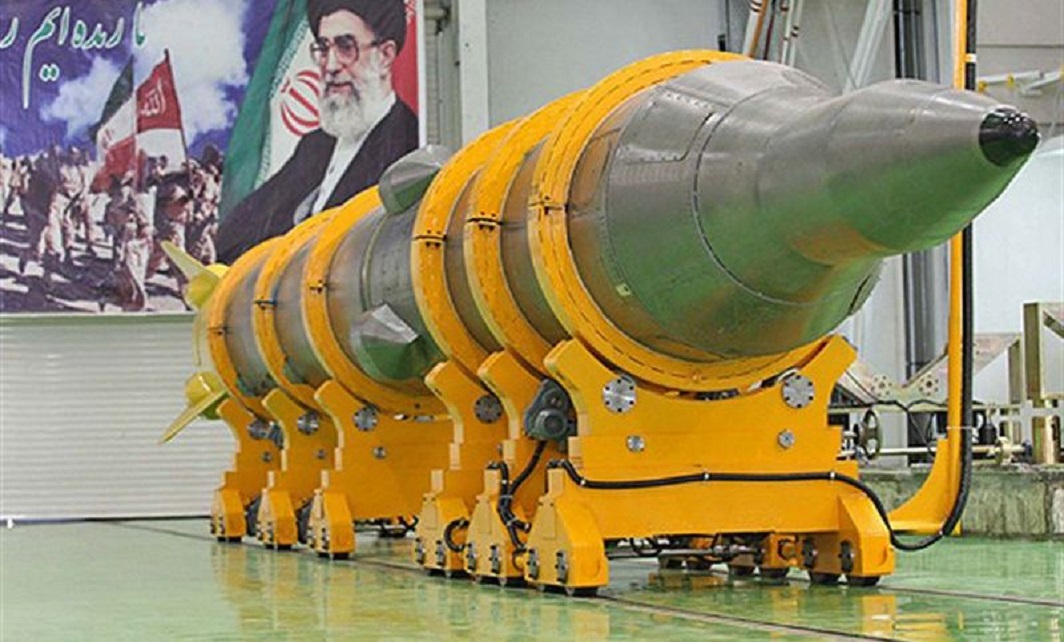 The Struggle over the Iranian Nuclear Program.It is incumbent on Israel to use all the diplomatic and political tools at its disposal to halt the signing of an accord with Iran that leaves Teheran with the capability to produce nuclear weapons. We are currently at a decisive stage in the struggle over the fate of the Iranian nuclear program, with the center of attention being the negotiations over the future of the plan between the great powers, with the United States at the forefront, and Iran. The question currently being aired is whether Iran will be willing to accept a watered-down list of restrictions on its nuclear activity, in return for the incremental lifting of a range of sanctions currently in place against it.
The Struggle over the Iranian Nuclear Program.It is incumbent on Israel to use all the diplomatic and political tools at its disposal to halt the signing of an accord with Iran that leaves Teheran with the capability to produce nuclear weapons. We are currently at a decisive stage in the struggle over the fate of the Iranian nuclear program, with the center of attention being the negotiations over the future of the plan between the great powers, with the United States at the forefront, and Iran. The question currently being aired is whether Iran will be willing to accept a watered-down list of restrictions on its nuclear activity, in return for the incremental lifting of a range of sanctions currently in place against it.
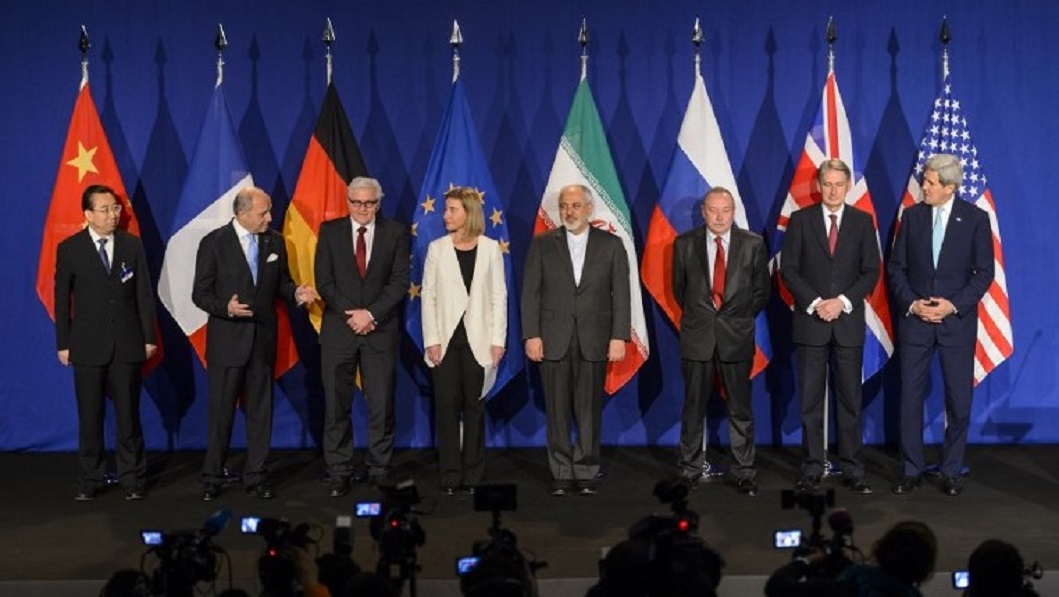 In 2015, Iran agreed a long-term deal on its nuclear programme with the P5+1 group of world powers - the US, UK, France, China, Russia and Germany.It came after years of tension over Iran's alleged efforts to develop a nuclear weapon. Iran insisted that its nuclear programme was entirely peaceful, but the international community did not believe that.Under the accord, Iran agreed to limit its sensitive nuclear activities and allow in international inspectors in return for the lifting of crippling economic sanctions.
In 2015, Iran agreed a long-term deal on its nuclear programme with the P5+1 group of world powers - the US, UK, France, China, Russia and Germany.It came after years of tension over Iran's alleged efforts to develop a nuclear weapon. Iran insisted that its nuclear programme was entirely peaceful, but the international community did not believe that.Under the accord, Iran agreed to limit its sensitive nuclear activities and allow in international inspectors in return for the lifting of crippling economic sanctions.

